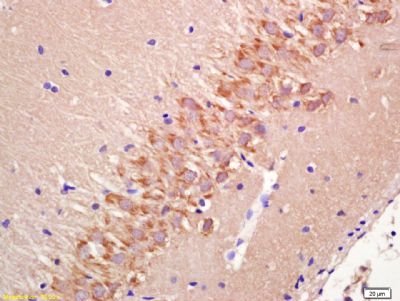FMN2 Polyclonal Antibody
Purified Rabbit Polyclonal Antibody (Pab)
- SPECIFICATION
- CITATIONS
- PROTOCOLS
- BACKGROUND

Application
| IHC-P, IHC-F, IF, E |
|---|---|
| Primary Accession | Q9NZ56 |
| Reactivity | Rat, Dog, Bovine |
| Host | Rabbit |
| Clonality | Polyclonal |
| Calculated MW | 189 KDa |
| Physical State | Liquid |
| Immunogen | KLH conjugated synthetic peptide derived from human FMN2 |
| Epitope Specificity | 401-500/1722 |
| Isotype | IgG |
| Purity | affinity purified by Protein A |
| Buffer | 0.01M TBS (pH7.4) with 1% BSA, 0.02% Proclin300 and 50% Glycerol. |
| SUBCELLULAR LOCATION | Expressed almost exclusively in the developing and mature central nervous system. |
| SIMILARITY | Belongs to the formin homology family. Cappuccino subfamily.Contains 1 FH1 (formin homology 1) domain. Contains 1 FH2 (formin homology 2) domain. |
| Post-translational modifications | Phosphorylated upon DNA damage, probably by ATM or ATR. |
| Important Note | This product as supplied is intended for research use only, not for use in human, therapeutic or diagnostic applications. |
| Background Descriptions | FMN2 is a member or the formin homology family, Cappuccino subfamily. Formin homology (FH) domain proteins play a role in cytoskeletal organization and/or establishment of cell polarity. In mice, FMN2 has been shown to be a maternal effect gene that is expressed in oocytes and is required for progression through metaphase of meiosis I. FMN2 is expressed in the developing and mature central nervous system. |
| Gene ID | 56776 |
|---|---|
| Other Names | Formin-2, FMN2 |
| Dilution | IHC-P=1:100-500,IHC-F=1:100-500,IF=1:100-500,ELISA=1:5000-10000 |
| Storage | Store at -20 ℃ for one year. Avoid repeated freeze/thaw cycles. When reconstituted in sterile pH 7.4 0.01M PBS or diluent of antibody the antibody is stable for at least two weeks at 2-4 ℃. |
| Name | FMN2 |
|---|---|
| Function | Actin-binding protein that is involved in actin cytoskeleton assembly and reorganization (PubMed:21730168, PubMed:22330775). Acts as an actin nucleation factor and promotes assembly of actin filaments together with SPIRE1 and SPIRE2 (PubMed:21730168, PubMed:22330775). Involved in intracellular vesicle transport along actin fibers, providing a novel link between actin cytoskeleton dynamics and intracellular transport (By similarity). Required for asymmetric spindle positioning, asymmetric oocyte division and polar body extrusion during female germ cell meiosis (By similarity). Plays a role in responses to DNA damage, cellular stress and hypoxia by protecting CDKN1A against degradation, and thereby plays a role in stress-induced cell cycle arrest (PubMed:23375502). Also acts in the nucleus: together with SPIRE1 and SPIRE2, promotes assembly of nuclear actin filaments in response to DNA damage in order to facilitate movement of chromatin and repair factors after DNA damage (PubMed:26287480). Protects cells against apoptosis by protecting CDKN1A against degradation (PubMed:23375502). |
| Cellular Location | Cytoplasm, cytoskeleton. Cytoplasm, cytosol. Cytoplasm, perinuclear region {ECO:0000250|UniProtKB:Q9JL04}. Nucleus Nucleus, nucleolus. Cell membrane {ECO:0000250|UniProtKB:Q9JL04}; Peripheral membrane protein {ECO:0000250|UniProtKB:Q9JL04}; Cytoplasmic side {ECO:0000250|UniProtKB:Q9JL04}. Cytoplasmic vesicle membrane {ECO:0000250|UniProtKB:Q9JL04}; Peripheral membrane protein {ECO:0000250|UniProtKB:Q9JL04}; Cytoplasmic side {ECO:0000250|UniProtKB:Q9JL04}. Cytoplasm, cell cortex {ECO:0000250|UniProtKB:Q9JL04}. Note=Colocalizes with the actin cytoskeleton (PubMed:20082305). Recruited to the membranes via its interaction with SPIRE1 (By similarity). Detected at the cleavage furrow during asymmetric oocyte division and polar body extrusion (By similarity). Accumulates in the nucleus following DNA damage (PubMed:26287480). {ECO:0000250|UniProtKB:Q9JL04, ECO:0000269|PubMed:20082305, ECO:0000269|PubMed:26287480} |
| Tissue Location | Expressed almost exclusively in the developing and mature central nervous system. |

Thousands of laboratories across the world have published research that depended on the performance of antibodies from Abcepta to advance their research. Check out links to articles that cite our products in major peer-reviewed journals, organized by research category.
info@abcepta.com, and receive a free "I Love Antibodies" mug.
Provided below are standard protocols that you may find useful for product applications.
If you have used an Abcepta product and would like to share how it has performed, please click on the "Submit Review" button and provide the requested information. Our staff will examine and post your review and contact you if needed.
If you have any additional inquiries please email technical services at tech@abcepta.com.













 Foundational characteristics of cancer include proliferation, angiogenesis, migration, evasion of apoptosis, and cellular immortality. Find key markers for these cellular processes and antibodies to detect them.
Foundational characteristics of cancer include proliferation, angiogenesis, migration, evasion of apoptosis, and cellular immortality. Find key markers for these cellular processes and antibodies to detect them. The SUMOplot™ Analysis Program predicts and scores sumoylation sites in your protein. SUMOylation is a post-translational modification involved in various cellular processes, such as nuclear-cytosolic transport, transcriptional regulation, apoptosis, protein stability, response to stress, and progression through the cell cycle.
The SUMOplot™ Analysis Program predicts and scores sumoylation sites in your protein. SUMOylation is a post-translational modification involved in various cellular processes, such as nuclear-cytosolic transport, transcriptional regulation, apoptosis, protein stability, response to stress, and progression through the cell cycle. The Autophagy Receptor Motif Plotter predicts and scores autophagy receptor binding sites in your protein. Identifying proteins connected to this pathway is critical to understanding the role of autophagy in physiological as well as pathological processes such as development, differentiation, neurodegenerative diseases, stress, infection, and cancer.
The Autophagy Receptor Motif Plotter predicts and scores autophagy receptor binding sites in your protein. Identifying proteins connected to this pathway is critical to understanding the role of autophagy in physiological as well as pathological processes such as development, differentiation, neurodegenerative diseases, stress, infection, and cancer.


